* THE
DIVINE ARRIVAL
*
OF
THAKUR SHRI RADHA GOVIND DEVJI MAHARAJ
TO JAIPUR

















|
|

|

|

|
|
|
 |
|


|
|
 |
|
 |
| |
Whenever
human intellectual or visionary forces get
blurred or obscured by the clouds of doubts, distrust or dismay they find their
way in the Lotus Feet of This INFINITY.
GOVIND,
the Ocean of Mercy and Affection, never lets them fail. The keys of Universal
peace, Universal love, Universal Fraternity AND Redemption from the path of
error are delivered to the humanity with the DIVINE Solace continuously being
showered from the Lotus Palm of Thakur Shri Govind Devji Maharj, Jaipur.
The History of
Jaipur was enriched with a Golden Page When before
laying of Foundation Stone of Jaipur, On Basant Panchmi Thakur Shri Radha-Govind Devji Maharaj Enshrined in Jai
Niwas
Gardens ( Mandir Shri Govind Devji
Maharaj ).
.......The Divine Delight of HIS Presence and The Perennial
Fountain of Spritual Solace started Gliding Across the Atmosphere !!
AND IT WAS ALSO BEGINING OF A NEW ERA;
Under the DIVINE Patronage of Lord GOVINDDEVJI,
on18th November, 1727 the foundation stone of Jaipur was
laid at Gangapole. The Kachhwaha Dynasty of the Rulers of
Erstwhile Amer Kingdom who laid the foundation of JAIPUR, The Pink City of
India, SUBMITTED THEMSELVES To The Lotus Feet Of Thakur GOVIND DEVJI Maharaj.
They Acclaimed GOVIND As The Sovereign King Of This Kingdom And surrendered
themselves as the subservient courtiers to HIM. King Raja Sawai Jaisingh
got inscribed in his Sovereign Seal "Shri Govinddev Charan, Sawai Jaisingh Sharan".

Today though HE physically resides in this
Temple, Practically HE is in the Breaths of The People. HE is Their Faith, Their Inspiration,
Their Shelter!!! HE is Their
Friend, Philosopher & Guide! HE is
not only a Sacred Image of Worship; But HE lives in them and The People Live in
HIM. In HIM Somebody finds his Brother, Somebody his Friend (Sakha), yet
Somebody else his Medicine and So On
...............!!! "The Aradhya Deva of Jaipur", Lord Govind
Devji Majharaj cannot be seen separately from the life of people of Jaipur.
The number of Devotees visiting the Temple
daily runs to Thousands and to Lakhs
on Festive Days.
Large
number of people of Vaishnava Discipline from Bengal, Bihar, Manipur & Assam
come here to pay their homage & take a dive into this Celestial Stream of
Boons & Blessings !
Celebrities feel it their proud privilege to perform before HIM !!!
The Manifestation story
of 'GOVIND' descends from the GOLDEN CORRIDORS OF Ancient Indian Heritage. As
is the Legend, the Holy Image of Lord Govind Devji was also called "BAJRAKRIT"
communicating thereby that it was created by Bajranabh – The Great Grand Son of
Lord Shri Krishna.
SOME 5,600 YEARS BACK
WHEN SHRI BAJRANABH WAS AROUND 13 YEARS OF AGE, he asked his Grand Mother(daughter-in-law
of Lord Krishna) as to how Lord Shri Krishna looked like; and made an image as
per the description given by her mother. She however, said that not all but the
Feet of that image looked like those of Lord Shri Krishna. He made another
image, yet this time again she said that only the Chest looked like that of Lord
Shri Krishna. Thereafter, He made Third Image and looking at the same she felt
Blush and Nodded that yes that was what Lord Shri Krishna Looked Like..!!! The
First One came to be known with the Name Lord "Madan Mohanji". The Second One
got recognition as Lord "GOPI NATHJI". AND the Third One, The LIVE Divine
Majestic Holy Image is LORD "GOVIND DEVJI", The One whom we all call “ARADHYA
DEV OF JAIPUR”.
With
passing of ages the glories of the Indian
Culture were being forgotten and the sands of time kept piling up. Togetherwith every other thing these pious divine images were also lost from the
memories of people. Some 500 years ago Lord Chaitanya Mahaprabhu took his
birth on the Indian Soil and did the massive work to remove the layers of
ignorance & infuse back in our lives the forgotten vitality of great grand
Indian Past....
Vrindavn
Dham had become almost a Jungle by the early 16th Century. No trace of the
original place was left at the site. Lord Chaitanya Mahaprabhu had visited
the site in 1514 A.D. and had discovered some of the places mentioned in the
Bhagvat Purana. But he was not able to stay here long enough to bring out
the complete Glory of The Place.
|
Before the reign of Emperor Akbar, On the
behest of Chaitanya Mahaprabhu, his immediate disciples,
two brothers Shri Roop Goswami & Shri Sanatan Goswami came to Vrindaban to
Spread the Doctrines of Vaishnavism & to discover the lost holy sites.
To revitalize the principles of True Love &
Devotion and re-establish the glorious
identity of this land of Lord Krishna,
they were later joined by their nephew shri
|
|
 |
Jeeva
Goswami & others, viz., Shri Raghunath Bhatt, Shri Raghunath Das and Shri Gopal
Bhatt. These six distinguished disciples of Chaitanya Mahaprabhuji later gained the name of "SHAD GOSWAMI" (The
Six Goswamis).

Shri Jeev Goswami |

Shri Raghunath Bhatt |

Shri Raghunath Das |

Shri Gopal Bhatt |
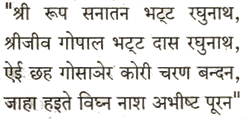
It was while His Holiness Shri Roop Goswami was residing in Vrindaban & preaching the Doctrines of Vaishnavism that coming into
his Divine Dreams, LORD GOVIND DEVJI Revealed HIMSELF to
him at GOMA TEELA in Vrindaban, on Basant Panchami in the year 1525.

The
news of Manifestation of Lord Govind Devji to Shri Roop Goswami
was immediately sent to
 CHAITANYA
MAHAPRABHUJI (GAURANG MAHAPRABHU)
in Nilachal at Orrissa so that He should come to
Vrindaban. However, Due to his
illness, Mahaprabhuji made a
small image of eight metals (Ashtadhatu) depicting himself for the purpose of
Getting 'Darshana' and injected his Divine Power into the image. He sent this image of him with his
closely trusted & beloved Shriman
Kashishwar Pandit Mahodaya to V CHAITANYA
MAHAPRABHUJI (GAURANG MAHAPRABHU)
in Nilachal at Orrissa so that He should come to
Vrindaban. However, Due to his
illness, Mahaprabhuji made a
small image of eight metals (Ashtadhatu) depicting himself for the purpose of
Getting 'Darshana' and injected his Divine Power into the image. He sent this image of him with his
closely trusted & beloved Shriman
Kashishwar Pandit Mahodaya to V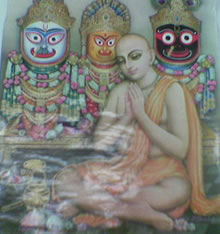 rindaban. The Image was given a holy bath (Abhishek)
and was placed on the Right of Lord Govind Devji. It gained the name of Thakur Shri Gaur Govind . It is believed that thereafter in
a span of a year Mahaprabhuji entered inside the temple of Lord
JAGANNATHJI in Puri enchanting the Harinam Sankirtan
AND merged his being into the
Divinity. rindaban. The Image was given a holy bath (Abhishek)
and was placed on the Right of Lord Govind Devji. It gained the name of Thakur Shri Gaur Govind . It is believed that thereafter in
a span of a year Mahaprabhuji entered inside the temple of Lord
JAGANNATHJI in Puri enchanting the Harinam Sankirtan
AND merged his being into the
Divinity.
The
Great Founder of the Madhviya Gauria Sampradaya, 1008 Shri Chaitanya Dev Mahaprabhu is believed to
be the spiritual incarnation of Lord Shri Krishna Himself and thereby goes the saying :
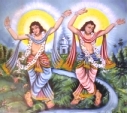

He had a unique white golden
complexion and, therefore, gained the name of "Gaurang Deva". "Gaur" was his popular name. After Him ‘Bengal’
came to be known as 'Gaur Desh' as well.
Nitai was his elder brother. He
was born in Navadwipa ( West Bengal)
at Mayapur on Phalgun Purnima in 1486 A.D.. Therefrom begins the History of This Glorious Heritage which this Thikana of Mandir Shri Govind
Devji Maharaj continues to uphold !
The Imperial Divine Majesty of Lord Govind Devji
Maharaj and both the brothers, Roop & Sanatan Goswami commanded a great
influence over the Native Princes and the Moghul Emperor Akabar, so much so that
the Emperor Akbar felt himself dignified in
Bestowing 135 Bighas of Land of Vrindaban to Thakur Shri
Govind Devji Maharaj !
|
In the
year 1590, the 34th year of the
reign of Akbar, under the directions of the
Goswamis,
|
|
Maharaja Man Singh of Amber, the Renowned
Governor in the Days of Emperor Akbar,
built the Famous Red Sand Stone Temple
at Vrindaban, U.P., at the same spot ( i.e.,
GOMA -TEELA ) where LORD GOVIND DEVJI Manifested
HIMSELF to Shri Roop Goswami. The Divine Sacred
Image of GOVIND DEVJI MAHARAJ was Consecrated in the
Temple under the Sole
|
 |
Sewa of the then Sewadhikar, Shri Hari Das
Goswami, the 2nd in the Chain of
Sewadhikaris.
INCLUSION
OF THE DIVINE IMAGE OF ADHYA SHAKTI RADHA RANI:
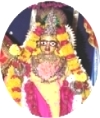

The Sacred Image of Radha Rani as the saying goes, was
earlier in Vrindaban and known as one of the incarnations of Divine Goddess
Shakti. For the reasons of security
from the growing danger of yavanas, a brahamin named "Vrihadbhanu” took the
Divine Image to Radhanagar in Orissa. After the death of Vrihadbhanu, The King
of Orissa, Prataprudra established the Divine Image in a place called Chakravedh
in Puri where it gained fame as "Laxmi Thakurani". After Prataprudra, When King Purushottam
of Orrisa (Son of Raja Prataprudra) learned about the
Appearance of the image of Lord
Govind Devji in Vrindaban, he sent this Divine Image which actually was of Shakti Swaroopa Radha Rani, to Vrindaban.
He occasioned the marriage of Radha
Rani with Lord Govind Devji Maharaj with a lot of pomp in Samvat 1690 (The year
1633); AND The Adhya Shakti Radha Rani's
Sacred Image was placed to the left of Lord Govind Devji.
back to top

In the Year 1669 A.D.
, during the reign of Aurangzeb when religious fanaticism was at its height, Shri Shiva Ram Goswami, the then Sole
Sewadhikari of Lord Govind Devji Maharaj, shifted the Divine Holy Images under
the protection of the then Amber Ruler, First to Kama Via Barsana, Radhakund AND
THEN to Govindpura Village (Ropara ).
The Images reached Kanak Vrindavan (in Amer valley) in 1714 and were
taken uphill to Jainiwas (Amer) in 1715. Finally, The Divine Holy
Images were enshrined in "Suraj
Mahal" of the City Palace (The Present Temple Premises) in Jai Niwas Gardens.
|
As per
a popular saying the choice
of this place was made by LORD GOVIND DEVJI
HIMSELF.
The 289th
Descendent of KUSH (The Elder Son Of Prabhu Shri RAM), King |
 |
Sawai Jai Singh,
the
founder of Jaipur lived in "Suraj Mahal". One night he dreamt that 'this
place was meant for
THE DIVINITY
and he should leave it'. The next day
under the guidance of the then Goswamiji, he left the place and went to
"Chandra Mahal". Before the foundation of Jaipur was laid, Lord
Govind Devji enshrined in Suraj Mahal and it became “The Temple”.
|
back to top

Inclusion
of Sakhis ( Female Friends ):
On
Asoj Budi 11, Samwat 1784 (Hindi Month) [The year
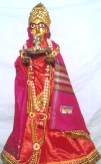 1727], the Image of Sakhi Vishakha was offered by
Maharaja Jai Singhji (Second) of Jaipur for Itra sewa (b= lsok
-
offering Perfume ) and placed on the left hand side of Radha Govind Devji.
Afterwards in Samwat 1858 [ The year 1801 ], Maharaja Sawai Pratap Singhji offered
the image of Sakhi Lalita for
Tambul Sewa (rkEcwy lsok
offering Beetle Leaves). The Image was
placed on the Right Hand Side of Radha Govind Devji Maharaj. 1727], the Image of Sakhi Vishakha was offered by
Maharaja Jai Singhji (Second) of Jaipur for Itra sewa (b= lsok
-
offering Perfume ) and placed on the left hand side of Radha Govind Devji.
Afterwards in Samwat 1858 [ The year 1801 ], Maharaja Sawai Pratap Singhji offered
the image of Sakhi Lalita for
Tambul Sewa (rkEcwy lsok
offering Beetle Leaves). The Image was
placed on the Right Hand Side of Radha Govind Devji Maharaj.
The sacred images of the personal adorations of the former Sewadhikaris are also placed
on the Dais besides Lord Govind Devji Maharaj, on a small throne. These are small sacred black stone (dkLVh iRFkj
) representative idols known as "SALIGRAMJI" (depicting LORD
NARAYAN HIMSELF). On a yet smaller
throne is the small image of Lord Krishna in the
Dais besides Lord Govind Devji Maharaj, on a small throne. These are small sacred black stone (dkLVh iRFkj
) representative idols known as "SALIGRAMJI" (depicting LORD
NARAYAN HIMSELF). On a yet smaller
throne is the small image of Lord Krishna in the
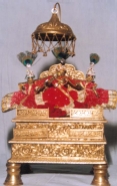 middle
of HIS two nearest sakhis (female friends), known as "JUGAL KISHORI JEU" worshipped by Late
His Holiness Goswami Shri Shyam Sunder Devji at
his residence (who left for Heavens in 1888), the great-great grand father of
the Sewadhikari, Shri Anjan Kumar Goswami.
The Ancient Image Of Lord Saligramji which came to Jaipur with Lord Govind Devji Mahraj Himself is on another
smaller throne. middle
of HIS two nearest sakhis (female friends), known as "JUGAL KISHORI JEU" worshipped by Late
His Holiness Goswami Shri Shyam Sunder Devji at
his residence (who left for Heavens in 1888), the great-great grand father of
the Sewadhikari, Shri Anjan Kumar Goswami.
The Ancient Image Of Lord Saligramji which came to Jaipur with Lord Govind Devji Mahraj Himself is on another
smaller throne.
 |
The present Grandeur
of The Temple was attained during the period of
Revered His Holiness Late Shri Pradhyumna Kumarji Goswami, the just preceding
Sole Sebait (lsck;r
).
Exemplary was his life.
He devoted himself to the cause of the
Temple and to the service
of the Devotees. The poet has
rightly said for such Great Lives: "Lives Of All Great Men Remind Us To Make Our
Lives Sublime; And Following Them Leave Behind Us Footprints on the Sands of
Time".
|
 |
The
Journey is not only well maintained but is Advancing Ahead to new heights in the
hands of his Able Successor Shri Anjan Kumar Goswami, the Present Sole Sebait. The same drive, devotion & dedication is
evident in Shri Manas Kumar Goswami (son of Shri Anjan Kumar Goswami) who after
his education has joined hands with his father in the Divine Cause.
|
 |
back to top

The
Temple Shri Govind Devji Maharaj,
situated at Jai Niwas Garden Campus, Jaipur 302 002, is
a Registered Public Trust
with the Devasthan Vibhag, Govt. of Rajasthan, Jaipur vide Regn. No. 346 dated
20-9-1972. This is a self sustained, independent Thikana
(ENTITY). Thakur Govind Devji
Maharaj HIMSELF being a Perpetual Minor, the sole sewadhikari (lsokf/kdkjh
-
, the sole trustee) is the permanent
guardian.
From the Emperor of India to the lay man in the street,
everybody without any sectarian bias, has paid his homage by virtue of grants &
gifts. Rulers of different states & people from
abroad have all contributed to the cause of Thakur Shri Govind Devji Maharaj !
In Vrindavan itself, Seventy Five percent
of Vrindavan was the property of Thikana Mandir Shri Govind Devji
Maharaj only.
Token Annuities to this Thikana from Bankura
(West Bengal) & from Govt. of Rajasthan still continue. The Rulers of erstwhile
Jaipur State regarded Govind Devji Maharaj as their King (Raja –
jktk
).
The Trust is Governed and managed by its Sole
Trustee. The Glorious Heritage finds
its Origin from 1008 SHRI SHRI
CHAITANYA MAHAPRABHU, the founder of the MADHVIYA GOURIA
SAMPRADAYA. Right Since the Times of Akbar the Great, the Heritage in
its chain, descends now to the present Sole Trustee, SHRI ANJAN
KUMAR GOSWAMI, Tikai (Eldest Son) of Late Shri Pradhyumna Kumarji
Goswami.
back to top

 True Love, Devotion &
"Krishna Leela Prasar" are the
Aims,
Objectives & Activities of the
Temple. Universal Peace, Universal Love, Universal
Brotherhood and Relief from the sufferings, are the causes,
the Temple nurtures. Upholding these high values of the Madhviya Gauriya
Sampradaya, laid down by the Great Gaurang Deva more than 500 years
ago, the Temple is constantly on the march to the Path Ahead.............
. True Love, Devotion &
"Krishna Leela Prasar" are the
Aims,
Objectives & Activities of the
Temple. Universal Peace, Universal Love, Universal
Brotherhood and Relief from the sufferings, are the causes,
the Temple nurtures. Upholding these high values of the Madhviya Gauriya
Sampradaya, laid down by the Great Gaurang Deva more than 500 years
ago, the Temple is constantly on the march to the Path Ahead.............
.

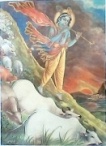 |
In this
Land of Lord Krishna, the Cow holds a sacred position & is rightly
named "Gau Mata" ( The Mother Cow ).
It plays a significant role in the lives of people & the economy of
this Nation; the Temple commits itself to the security, service & betterment of the Cow and
motivates the people at large to this benevolent & pious cause!
|
 *The
Sacred Cow - *
Abode of Deities !
*The
Sacred Cow - *
Abode of Deities ! |
|
|
back to top

| |
The
Temple is the Governing Body of the Chain of Temples at Vrindaban (U.P.), Radhakund (U.P.),
Barsana (U.P.), Kama
(Bharatpur-Rajasthan), Village Ropara (Govind Pura,Jaipur),
Amer
Valley and at other different sites in
Jaipur.
The
Donations to The Temple are Exempt from Income Tax Under Section 80-G of the Income Tax Act of Govt. of India. The Donations may be made both in Cash & Kind. Bank Drafts & Cheques to be Marked
"A/c. Payee Only". If one so intends, the Donor may
also specify any specific purpose for the use of his donations. All Donations to be sent in the Name of
MANDIR SHRI GOVIND DEVJI MAHARAJ, Jaipur.
All Communications to be addressed to :
| |
Shri Anjan Kumar Goswami,
(Mahant – Sebait & Manager – Sole Trustee)
Temple Shri Govind Devji Maharaj, JAIPUR (Rajasthan), INDIA
Phones: 091-0141-2619413 (Office)
091-0141-2606452 ( Resi.)
Website:
www.govinddevji.net
Email :  mandir@govinddevji.net
mandir@govinddevji.net
 govind.mandir@gmail.com
govind.mandir@gmail.com
|
|
Donations can be
made ONLINE as well, through Internet Banking, Credit Card and Debit
Card by logging-in to
http://www.govinddevji.net/ . Daily LIVE ONLINE DARSHAN
direct from The Temple also available at http://www.govinddevji.net/live.htm. back to top

|
|
|
















|
__________________________


*"HEAD OF ENDOWMENT"*
Mandir Shri Govind Devji Maharaj,
Jai
Niwas
Gardens,
JAIPUR 302 002
*
THE
GENEALOGY*
| |
Chaitanya Mahaprabhu sent his immediate disciple shri
Roop Goswami to Vrindaban.
Lord Govind Devji Maharaj Manifested HIMSELF to His Holiness Shri
Roop Goswami.
He thus became the First lsokf/kdkjh
(Sevadhikari). After him, his successors inherited this right.
In anticipation of a visit from Aurangzeb (the iconoclast Moghul
Emperor), Lord Govind Devji Maharaj & other Divine Holy Images were
ultimately shifted to Jaipur.
The male custom head of Goswami Family has ever since
been regarded as the Head Of Endowment. The Succession inherited in the
posterity to the Eldest Son by virtue of Jyeshthadhikar (T;s"Bkf/kdkj
)/ law of primogeniture.
In 1972, the trust was duly registered under sole
trusteeship with the Devasthan Vibhag, Govt. of Rajasthan, Jaipur, laying down the mode of succession
to "Jyeshthadhikar" ("T;s"Bkf/kdkj ") in line with this traditional custom. In the sole trustee vest all the rights to govern & manage
the property, funds, seva-puja (lsok&iwtk) and / or anything permanently or temporarily appropriated to any object
belonging to the Deity. The Genealogy was well defined,
ratified and decided in the court of law. It runs as follows:
*THE GENEALOGY * |
|
| |
1. Shri Roop Goswami
2. Shri Hari Das Goswami
3. Shri Govind Das Goswami
4. Shri Nityananda Goswami
5. Shri Radha Krishna Goswami
6. Shri Shiv Ram Goswami
7. Shri Krishna Charan Goswami
8. Shri Govind Charan Goswami
9. Shri Jagannath Goswami
10.Shri Ramsaran Goswami
|
11.Shri Balram Goswami
12.Shri Krishna Saran Goswami
13.Shri Ramnarain Goswami
14.Shri Hare Krishna Goswami
15.Shri Shyam Sunder Goswami
16.Shri Krishna Chandra Goswami
17.Shri Bholanath Goswami
18.Shri Pradyumna Kumar Goswami
( Left for his heavenly abode on 3-12-1997 )
19.Shri Anjan Kumar Goswami
20.Shri Manas Kumar Goswami
(Tikai son of Shri Anjan Kumar Goswami)
|
_____________
back to top

 |
* THE ROBES ( iks'kkd )* |
 |
| |
The Robes are primarily divided in Winter Wears & Summer Wears. Winter wears are known as "Jama
Paushak" – generally made of cotton / silk / Fibre / Parcha (a special
ornamental festive fibre).
Summer Wears include 'Dhoti-Dupatta' made of cotton, voil, malmal
and silk.

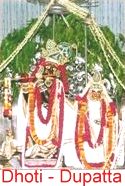
A decorative shining material called 'Gota' (prepared from gold / silver
/any other metal or other shining material fibres) is usually applied to
the robes.
The dresses also differ on the festive & auspicious days as follows:
1. Ekadashi (a fast day): Natwar –Vesh Paushak in blood red colour
with 'gota',
2. Poornima (full moon day): White Apparels with 'gota' on Sharad -
Poornima, it is in silver parcha. And
On Ras Poornima, it is in golden parcha
(Jama Paushaks)
3. Amavasya(moon less night): Black Apparels with 'gota'
4. Hindi 'Chaitra' Month : Apparels made from real flower buds with
flower-decorated wooden frames ( Buds of
Mogra, Rai-bel, Rajnigandha & Flowers of
Rose etc.)
|
|
____________________________________
 |
*THE ORNAMENTS & CROWNS (xgus
o eqdqV)*
( Golden and / or Silver Metal with Jewels)
|
 |
| |
Ekadashi : Inclined Mukut (Head Cap), Singa (fcxqy tSlk
), Chhari
(stick), Bansi (Flute), Kundal (Earings),
Chik (Neck Ornament), Hand Bangles,
Hath Phool, Haar, Locket Haar, Kamar
Peti (Waist Band), Eye Brow, Tilak, Kiran,
Kara (Leg-Bangle), etc.
Poornima: Different type of Mukut (crown),
Chhari (stick), Bansi, Kundal,
Hath Phool, Tilak, Kiran, Chik, Bangle, Kamar Peti, Kara,
Locket-Haar, Eyebrow etc.
Amavasya: Different type of Mukut and other ornaments
as above. |
|
_________________________________________________
 |
* Shringar * |
 |
| |
After Mangla Jhanki, the
make-up of all the SACRED IDOLS is done by the Pujaris
(
iqtkjh ) in the following sequence:
1. Bath is given with holy water. In winter warm water is used.
2. Dresses are changed
3. Saffron & Sandal Makeup (dslj &panu ls J`axkj) is done
4. Ornaments are put on
5. Finally
Real Flower Garlands ( rose, raibel etc.) are put on.
And then the "Dhoop Jhanki" is opened.
The make up remains the same till Sandhya Jhanki in the evening.
After closing of
"Sandhya Jhanki", the ornaments are taken off and the saffron-sandal
make up is removed.
Different dresses for night
are
changed (vksykbZ iks'kkd). Thereafter "Shayan Jhanki" is opened.
After close of
Shyan Jhanki, the Pujaris come out of Garbha Graha. The doors are closed & sealed.
The temple doors are closed.
For the convenience of the
visitors/ 'darshanarthis'/pilgrims, from Dhoop Jhanki to Shayan Jhanki,
the Office in the temple premises remains open which as well looks after and maintains the daily activities. |
|
back to top

____________________________
 |
As per Hindi Samvat Year, the following traditional festivals are
celebrated:
Month of Chaitra: 1. From Chaitra Sudi 1 (Pratipada) to Chaitra Sudi 9
( March-April-May )
(Navmi): Navratra
2. Chaitra Sudi 1 (1st day of Samvat Year,i.e.,New
Year Day):Indian New Year
Day; Worship of
Elephants.
3.Chaitra Sudi 3 (Teej) :
Sinjara – The famous
Gangaur
Festival
4.Chaitra Sudi 9 (Navmi): Ram Navmi; The Birth
1
Day of Lord Shri Ram
5.From Chaitra Sudi 12 (Dwadashi) to Baisakh
Sudi 8 (Ashtami): Mesh Sankranti
6.On Chaitra Sudi 11 (Ekadashi): Phool Bangla
(Flower Decoration),
Decoration with Rose Flowers
7.From Chaitra Sudi 15 (Poornima-the full moon
day) to Baisakh Sudi 15 (poornima):
"Sheetal Bhog": Sheetal –Thal Bhog is offered.
Month of Baisakh & Jyestha :
( April-May-June &
May-June-July )
1. Baisakh Sudi 3 (Akshaya Tritiya). Chandan -
Yatra. Saffron & Sandal Paste is applied to the
2
Divine Holy Images.
2. Baisakh Sudi 14 (Chaturdashi) –
Narsingh Jayanti: Pakhal Bhog is offered.
3. Baisakh Sudi 15 (Poornima) to Jyeshtha Sudi 13
(Trayodashi): Jalyatra; The Divine Holy Images are
ornamentally decorated with real flowers and placed
under the water showers amidst different fountains
(ty fogkj)
3
4.Jyestha Sudi 15 (Poornima): Snan Yatra (Luku
;k=k); A holly bath is given(vfHk"ksd) with Saffron+
Rose Water+Cow Milk+Honey+Curd+Ghee+
Boora(dust sugar)+Itra (b=). Thereafter Bhog of
various dishes is offerred. |
 |
 |
Month of Asharh:1.Asharh Sudi 2 (Dooj):
Rath Yatra; Thakur shri
( June-July-August ) Gaur Govind (the holy Ashtadhatu Image of Lord
Chaitanya Mahaprabhuji) is placed in the chariot
4
and taken to circumambulation(ifjdzek). Vaishnava
Mandli follows Dancing &
Enchanting "Harinam Sankirtan"
After taking 3 rounds of the main temple, the chariot
enters the Garbh Graha from the main entrance.
2.Asharh Sudi 11(ekadashi):Devshayani Ekadashi
Thakur Saligramji is placed in the chariot and
taken to the "Tulsi"(Brinda Devi) stand. After
Abhishek, Thakur Saligramji comes back.
3.Asharh Sudi 15 (Poornima): Guru Poornima;
The Disappearance(frjksHko) ceremony of Shri Pad
Sanatan Goswami is celebrated.
Month of Shravan: 1.From Shravan Sudi 2(dooj) to Shravan Sudi 15
(July-Aug.-Sep.) (poornima):The Festival Of Swings (fgaMksyk mRlo);
Thakurji takes the ride on the Swings.
5
2.Shravan Sudi 3 (teej): Ghewar (a special sweet
dish) bhog is offerred.
3.Shravan Sudi 15(Poornima):Raksha Bandhan;
The Rakhis (various ornamental
strings) are tied
to the wrists of the divine holy images. On this
day the sisters tie "Rakhi" on the wrists of their
brothers to save them from any sort of dangers.
Month of
Bhadrapad: 1.Bhadva Budi 8 & 9 (Ashtmi & Navmi):
( Aug-Sep-Oct )
Shri Krishna Janmashtmi,
the main festival of
the year; Celebrations of Lord Kirshna's Birth are
6
made on Ashtami & Nandotsava on Navmi.
Shobha
Yatra(a huge procession through the
Main markets of the City) takes place on Navmi
evening.
2.Bhadva Sudi 8 (ashtami):Radha Ashtami; The
festival of the birth of Adhya Shakti Radha Rani is
celebrated and Chhapan
Bhog (dishes of
minimum 56 varieties) are offerred to the deity.
3.Bhadva Sudi 15 (Poornima):
Shrimad Bhagwatotsava; Bhagwat
Katha
Ayojan (Holy discourses on Shrimad Bhagwatji) |
 |
 |
Month of
Ashvin: 1.From Asoj Sudi 1(ekam) to Asoj Sudi 9 (Navmi):
( Sep-Oct-Nov ):
Navratra Sthapna; Navratra Celebrations.
2.Asoj Sudi 10 (Dashmi): Vijaya Dashmi or Dashahara
Celebrations
7
Kheer Bhog (Sweet Dish made
with Rice & Milk) is offerred.
3.Asoj Sudi 15(Poornima): Sharad Poornima
Celebrations; A special additional "Jhanki"
(Darshan) is opened after the rising of Moon and
"Kheer Bhog" is offerred & distributed to the devotees.
4.From Asoj Sudi 15(Poornima) to Kartik Sudi 15
(Poornima):Aakashi Deepak; After evening, every
day "Aakashi Deepak"(a holy heavenly Lamp) is lighted.
Month of Kartik: 1.From Asoj Sudi
15(Poornima) to Kartik Sudi 15(Main
( Oct-Nov-Dec )
Punctual Sewa Pooja Month); Damodar Bhog
(Malpua-Kheer)
is offered daily.
8
2.Kartik Budi 15 (Amavasya):Deepawali Celebrations
3.Kartik Sudi 1 (Pratipada): Annakut Celebrations;
"Chhappan Bhog" are offered on this day.
4.Kartik Sudi 8 (Ashtami): Gopashtami;
The Holy "Cow" (
xkS ekrk
) is worshipped
5.Kartik Sudi 15 :(End of Punctual Sewa Pooja Month)
Ras Poornima Celebrations with special additional
Jhanki-Darshan; After Moon-Rise, "Kheer Bhog" is offered.
Month of Marg-Sheersha (Mangsar) & Paush (ikS"k) :
( Nov-Dec-Jan &
1.Mangasar Sudi 12 (Dwadashi):Vyanjan Dwadashi
Dec-Jan-Feb )
Celebrations;
Special Bhog is offered in a Special
Jhanki.
In all the Jhankis, a special "Kapoor Aarti"
9
(Aarti with Camphor) is done.
Throughout this whole
month in the Mangla Jhanki, holy bath (Abhishek) is
given to the deities daily
2.Mangsar Sudi 15 to Paush Sudi 15 ( Poornima ) :
Paush Khichdi Bhog (both Sweet & Saline) is offered.
10
3.Paush Budi 1 (Ekam) to Paush Sudi 15 (Poornima) :
Paush Bada Bhog made of Chaulai Dal (a pulse) is
offered & then prasadi distributed among the devotees |
 |
 |
Month of Magh: 1.Magh Budi 7(Saptami):Posh Sankranti(Mah Magh
( Jan-Feb-Mar )
Punyakal,i.e., sacred period of time of the month of
Magh ).
Makar
Sankranti is celebrated on Magh Budi
11
Saptami.
On this day "Til (a cereal) Bhog" is offered.
2.Magh Sudi 1 (Pratipada) to Magh Sudi 15
(Poonam):Peen Ka Laddoo (A sweet dish made from
rice-flour & dust of sugar) is offered.
3.Magh Sudi 5 (Panchami): Basant Panchami
Celebrations (Patotsav);
The ceremonies of holy
bathing (Abhishek of Thakur Shri Govind Devji) &
worship of Devi Saraswati ( goddess of intelligence &
education ), take place. All Basanti Paridhan
( yellow colour robes ) are put on by the deities .
Thereafter, Bhog as usual is offered.
4. Magh Sudi 7 ( Saptami ): Bhanu Saptami
(Surya Saptami);The"Advityacharya Mahaprabhu Jayanti" is
celebrated
5.Magh Sudi 13 ( Trayodashi ):
Nityananda
Mahaprabhu Patotsava Ceremonies
take place. Kheer & Malpua Bhog is offered.
Month of Falgun: 1.Falguni Budi 14 (Chaudas): Maha Shiv Ratri
( Feb-Mar-April ) Celebrations: Pooja-Aarti done by the Temple
Management in Mandir Shri Gopeshwar Mahadeo.
12
2.From Falgun Budi 10 (Dashmi) to Falguni Sudi 15
(Poornima): Rachna Fagotsava / Holika
Utsava;
From Falgun Budi Dashmi "Rachna Fagotsava
Jhankis are made using special type of dust colours;
Cultural Programmes are organised on Falgun Sudi
Ashtami, Navmi & Dashmi;
From Ekadashi to Chaudas and Poornima,
Fagotsava – the Festival of of "Holi" is celebrated.
Bhog is offerred as usual .
3.Falguni Sudi 11 (Ekadashi): Aanwala Ekadashi
( vkWaoyk ,dkn'kh ); Worship of Aanwala ( vkWaoyk ) plant
is done in temple
campus.
4.Falgun Sudi 15 ( Poornima ) :
Shri
Gaurang Mahaprabhu Patotsava celebrations;
In the evening 'Holy Bath' (Abhishek) is given to the
Image of Maha Prabhuji and the "Panchamrit" is
distributed to all Devotees. |
 |
back to top

| |

|
|
| |


*Sewa Paddati*
Mandir Govind Devji Maharaj is a Madhaviya
Gauriya Sampradaya Temple.
Madhaviya Gauriya Sampradaya has its origin in Bengal and was founded by Lord Chaitanya Mahaprabhu.
All the Temples & Devotional Centres of this Sampradaya (Sect)
follow the rituals, principles & system laid down in the Bengali Scriptures such as :
1.Hari Bhakti Vilas, written by Shrimad Gopal Bhatt Goswami, "Goureshvacharya"
2.Purohit Darpana,
compiled by Pandit Surendra Mohan Bhattacharya
The established routine system of Sewa (lsok) is known as 'Ashta-yam Sewa' in which Seven
Jhankis are opened daily for the public.
There are set Hymns (Hktu & dhrZu) for each Jhanki linked to the theme & emotions
inherent to that Jhanki. These are either in Hindi or in Bengali. When the "Kirtan" is at it's height, it is a live experience of
the presence of that OMNIPRESENT HIMSELF. WHAT HE Said comes
live:

It
is a deep divine experience to see the devotees fondly singing these
hymns with rhyme & rhythm. To taste the sweetness, one may recite the
following sample line & feel that transcendental experience for himself:

After the "Deeksha", the Goswamis, Sebaits (
-
), Pujaris and vaishnava Devotees start wearing (put
on) 'Tilak' known as 'URDHVA PUNDA' which signifies
the
bottom of the feet (pj.k) of Lord Govind (Lord Krishna –" Hkxoku ukjk;.k ").

This 'Tilak'
is made by Gopi Chandan Sand Stick & is put-on, on twelve Parts of the
body
enchanting the specified Mantras as mentioned here-under :
 |
|
Name of the Part of the Body
1. Forehead (yykV)
2. Navel (ukfHk)
3. Chest (o{k LFky)
4. Neck (daB)
5. Right Loin (dej
/ dq{kh)
6. Right Arm (cWakgq)
7. Right Arm lower portion
8. Left Loin (dej
/ dq{kh)
9. Left Arm
10. Left Arm lower portion
11. Upper Portion of the Back (ihB)
12. Lower Portion of the Back (dfV)
|
Mantra
Shri Keshvaya Namah
Shri Narayanaya Namah
Shri Madhvaya Namah
Shri Govindaya Namah
Shri Vishnava Namah
Shri Madhu Sudanaya Namah
Shri Trivikramaya Namah
Shri Vamnaya Namah
Shri Dharaya Namah
Shri Hrishikeshaya Namah
Shri Padmanabhaya Namah
Shri Damodaraya Namah
|
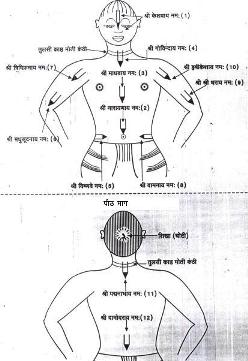 |
 |
|
The Last Step is to rinse the hands with water and to put the left
hand over the head
enchanting "Vasu Devaya Namah" !
back to top

 |
* The List of other Temples Governed & Maintained
*
Under The Thikana
Mandir Shri Govind Devji Maharaj, JAIPUR |
 |
|
| |
1. Radha Madhavji, Kanak
Vrindavan, Kanak Ghati,
Amer Road, JAIPUR
2. Devi Mansa Mataji, Kanak Ghati, Amer Road,
JAIPUR
3. Kunj Bihariji, Kanak Ghati, Amer Road,
JAIPUR
4
Kala Mahadevji, Kanak Ghati, Amer Road,
JAIPUR
5.
Bhura Mahadevji, "
"
"
6. Ganeshji, Kanak Ghati, Amer Road,
JAIPUR
7. Samadh Bari, (The Family
Crematorium of Goswamis),
Kanak Ghati,
Amer Road,
JAIPUR
8. Gopalji "NAGA", Outside Deori, Mandir Shri Govind Devji
Maharaj,
Farash Khana, City Palace,
JAIPUR
9.
Gopeshwar Mahadev,
"
"
"
10. Girdhariji, at Amania Chowk, temple premises of Mandir
Govind Devji
11
. Gopalji, Rajamal Ka Talab, Kanwar Nagar, JAIPUR
12.
Hanuman Garhi, Rajamal Ka Talab, Kanwar Nagar, JAIPUR
13. Murli Manoharji, Ramganj
Chopar, JAIPUR
14.
Gopalji, Ropara, Gram Govind Pura, Goner Road,
JAIPUR.
On its
northern side, under the hills, there also exist the ruins of
the old
temple
of Govind Devji Maharaj.
15.
Radha Govindji, Tehatra Gram, Rajgarh, Alwar
16.
Shri Govind Devji & Brinda Deviji, KAMA (near Deeg, Bharatpur)
17. Yog Maya Peeth, Old temple of Thakur Shri Govind
Devji at Vrindavan,
distt. Mathura,
(U.P.). The
Red
Sand
Stone Temple Building is Now
a
Monument under
the Archeological Deptt. at Agra excluding the
Main Temple Premises which constitutes of "The Yog Maya Peeth ".
This was the
place where Thakur Govind Devji Maharaj Revealed
HIMSELF to His Holiness Shri Roop Goswamiji. Now there exist the
Holy Images of Lord Jagannathji & Nityananda Mahaprabhuji.
Brinda Devi ( after
whom this
place has
been named 'Brindaban'
– Vrindavan )
existed on the southern side. This sacred image was
Found in Brahma Kunda,
Vrindavan and is now at Kama ( Bharatpur ) .
18. Govind Devji Maharaj,
the new
temple with a replica of Radha -
Govind Devji, Govind
Ghera, Vrindavan. This temple is just behind the
Old monument
of
Red Sand Stone Temple; And was built by
Shri Nand Kumar Basu, a
Bengali Devotee, in 1820.
19. Radha Govind Devji,
Radha Kund (U.P.)
20. Radha Govind Devji,
Anyor Gram, Goverdhan (U.P.)
21. Radha Govind Devji,
Barsana, behind bus stand (U.P.)




back to top

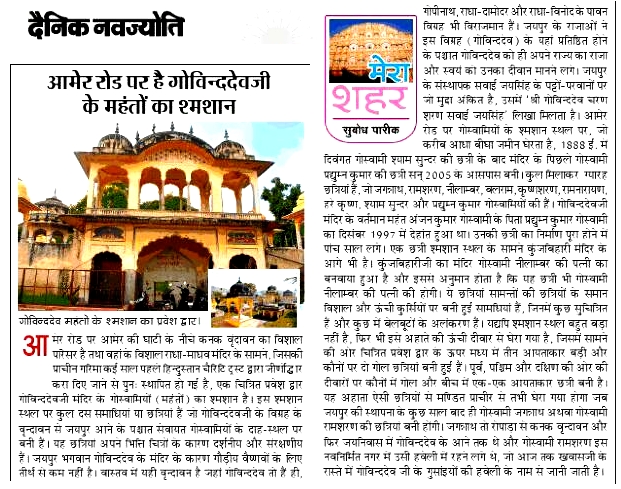
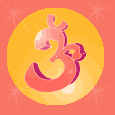

back to top

 


 
 
|
|
|
| |
|
|